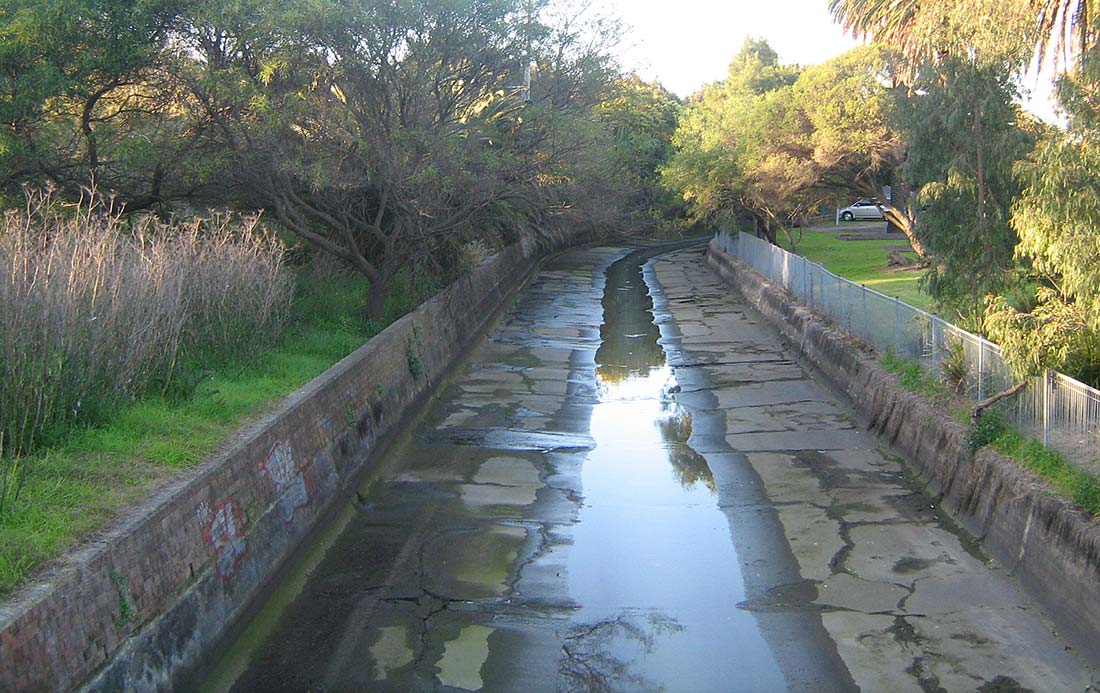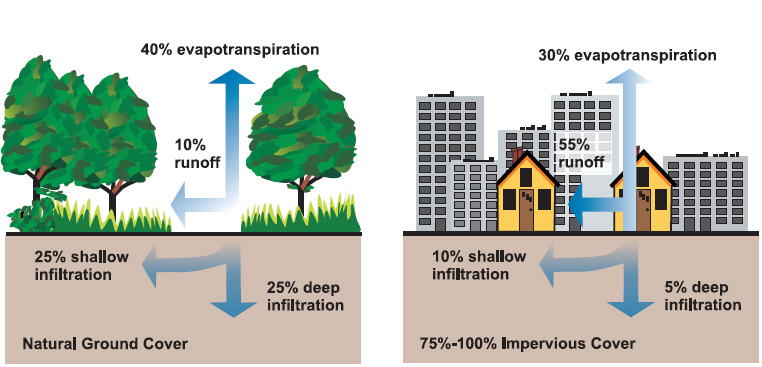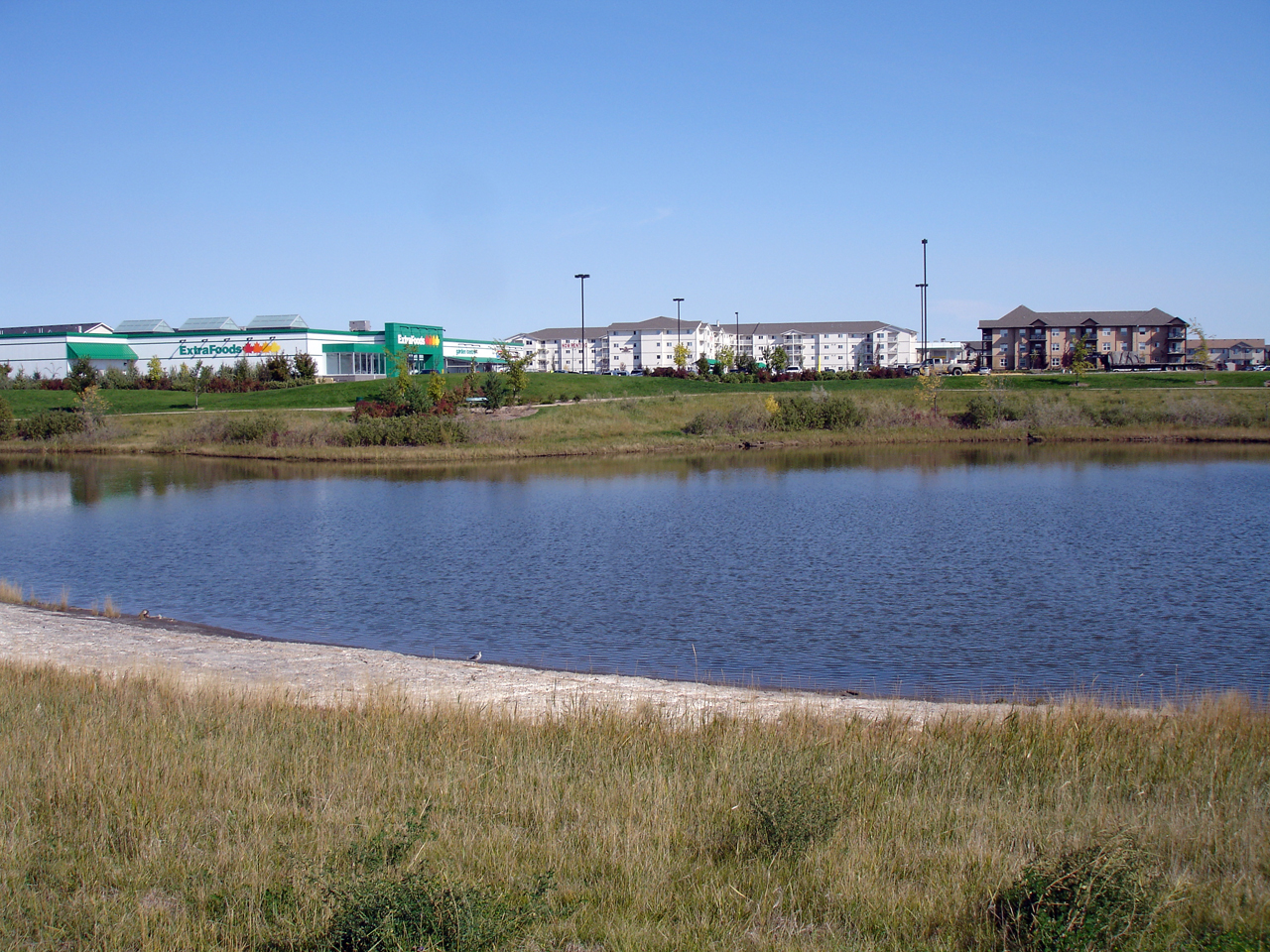Introduction

Concrete Stormwater Channel creating high velocity and high volume discharge of stormwater to natural receiving waters. Photo: Smegs07 Public Domain.
Stormwater is rainwater and melted snow that runs off streets, fields and landscapes. Naturally most stormwater is captured by soil and vegetation. It infiltrates and replenishes aquifers or flows into streams and rivers. In developed areas, however, pavement, roofs and other impervious surfaces prevent precipitation from infiltrating. Instead, the stormwater flows in greater volume and at a higher velocity into storm drains, sewer systems, and drainage channels like the one shown above. This urban stormwater is responsible for many problems in the built environment including downstream flooding, combined sewer overflow and infrastructure damage. In the natural environment it is responsible for stream bank erosion, habitat destruction, changes in stream flow characteristics and contamination of streams, rivers and coastal waters.
Stormwater Management

Development changes the natural hydrology of the watershed. Photo: EPA.
There is abundant and conclusive scientific literature demonstrating increased pollution, flooding, and erosion as well as decreased groundwater recharge as the impacts of urbanization on water resources. Large areas of connected impervious surfaces and other changes in land-use dramatically increase the volume and rate of stormwater discharges adversely affecting aquatic ecosystems and human health.
Stormwater management requires reduction of the rate and volume of runoff resulting from development. In the U.S., counties are generally the agencies that establish regulations to manage the rate and volume of stormwater from land-use change and human development. However, there are often also statewide regulations and large cities often establish their own surface or stormwater management agencies.
Non-Point Source Pollution

Trounce Stormwater Retention Basin Canada. Photo: Drm310, license CC-BY-SA-3.0
The U.S. Environmental Protection Agency (EPA), through the National Pollutant Discharge Elimination System (NPDES) Stormwater Program, regulates stormwater discharges from three potential sources: municipal storm sewer systems, construction activities, and industrial activities. The EPA increasingly requires cities and towns to limit the non-point pollution that they discharge to receiving streams, rivers, lakes and oceans. This is done by reducing the amount of stormwater runoff or improving its quality before it reaches receiving waters. Often the business groups balk at the cost of stormwater management fees that agencies propose in order to comply with NPDES stormwater standards. These groups and the public is generally unaware that a primary threat to human health and aquatic ecosystems is non-point pollution that results from stormwater runoff (Peters, 2009; Flint, 2007). This section of the course addresses the stormwater management issues while the following section takes up the water quality issues associated with stormwater runoff.

Stormwater is often difficult to manage in existing urban areas. This infill building in Hollywood, California won a LEED platinum rating. Its stormwater is collected in a tank below ground. Photo: Calder Oliver, license CC-BY-SA-3.0
Since the quality of the water entering receiving water requires improvement many stormwater quality improvement designs have been developed and tested. Their effectiveness, size, location and cost will be illustrated through engineering experiments and case studies (Davis, 2009) in the next section of the course.
Key to achieving acceptance of stormwater management plans is multiple functions. When stormwater quality facilities also achieve aesthetic, park and wildlife benefits then costs are more clearly balanced by benefits. Landscape architects are in a position to educate elected city and county officials, city administrators, public works personnel, extension agents, parks directors, and economic development agencies about stormwater problems and solutions.
Study Questions
Compare the evaporation, runoff, shallow infiltration and deep infiltration percentages for land with natural vegetation compared to urban areas with 75% impervious cover.
Stormwater management focuses on the reduction of which two stormwater characteristics?
Which U.S. Environmental Protection Agency program regulates stormwater discharges?
References
Environmental Protection Agency. National Pollutant Discharge Elimination System (NPDES). http://cfpub1.epa.gov/npdes/home.cfm?program_id=6. Accessed 1/15/2014
Flint, K., Davis, A.P., Pollutant Mass Flushing Characteristics of Highway Stormwater. Runoff from an Ultra Urban Area”. Journal of Environmental Engineering 2007, 133 (6), 616-626.
Peters, N. E., Effects of urbanization on stream water quality in the city of Atlanta, Georgia, USA. Hydrological Processes 2009, 23 (20), 2860-2878.